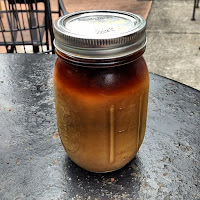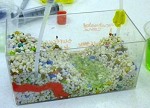by Michelle Dry, Education and Outreach Director for the
Center for Applied Earth Science and Engineering Research (CAESER) at the University of Memphis
For those of us who are out
in the trenches educating
our communities about the
sources of their drinking water when it
is groundwater, the question “Where
does your water come from?” is often
met with puzzled looks, especially from
some of the youngest members of our
communities – school-aged children.
They may reply the faucet or the sky,
but when pressed to guess, they often
reply with some creative responses,
such as the ocean, despite an ocean
being hundreds of miles away. In the
past year or so, another response has
been, “the sewer,” which is mostly likely
the result of the 2014 movie, “Teenage
Mutant Ninja Turtles.” Sometimes the
guess given is a body of water people
are familiar with, such as a nearby lake
or a river.
In the city where I work, Memphis,
Tennessee, another response I
sometimes hear is the Mississippi
River. Because Memphis is one of the
largest cities in the U.S. that solely uses
groundwater for its tap water, it is crucial
that its residents know and understand
the source of their tap water so that it
can be managed sustainably.
Part of my job is to educate the
public about the source of its drinking
water as well as why it is important
to preserve and protect it. Memphis
drinking water is highly praised by locals
and visitors. Because it is abundant
and of high quality, it is inexpensive,
compared to areas where it may
be scarcer and of lower quality. For
many, it is easy to take Memphis water
for granted. However, the biggest
cheerleaders for Memphis groundwater are typically those who have lived
elsewhere and those who have traveled
widely. The cheerleaders know just how
lucky Memphis is to have what is known
as the Memphis Sand aquifer.
Although I work with engineers
and geologists in my role at CAESER,
I am not one. It is my job to translate
their research efforts and results into
meaningful information for the Memphis
area community.
Because groundwater is not visible
on the surface of the Earth, the way a
river or lake is, even people who know
water cycle concepts may not always
know that the source of drinking water
for our area is water from an aquifer.
For those who do know that it comes
from an aquifer, they may not know
what an aquifer is, and they imagine it as
an underground cave or lake.
When it comes to educating people
about groundwater, whether they are
adults or children, there are challenges
to overcome because groundwater is
a something people cannot see. We
may be able to explain the concept in a
way that some people can understand.
However, if we can show that same
concept by using visuals, it is more likely
to be understood and remembered.
An ideal time to educate students
about local water sources is when they
are introduced to the water cycle. In
Tennessee, state science standards
require that the hydrologic cycle to be
taught in the 5th grade.
As a former classroom teacher, I
know that the teaching profession is
demanding and busy. Teachers often
have limited resources. Since leaving
the classroom, I have continued to
work with teachers through outreach
positions. When I reach out to teachers,
my philosophy is that if I can make their
job easier, I am more likely to have
success in reaching their students. I
build on what teachers are required
to teach and try to supplement their
efforts while extending student learning.
They want their students to understand
the hydrologic cycle and do well on
state standardized tests. My goals are
that students learn about their water
resources and become good stewards
of water, and that they understand how
water connects to our daily lives.
In trying to reach a maximum
number of students, the idea of a
traveling museum on wheels, or a
mobile learning lab, seemed to be an
efficient way connect with students from
all over the city and to nearby areas,
since they all use the same aquifer
system. I wanted this museum on
wheels to have the fun and excitement
of a field trip, without the issues that
sometimes accompany field trips, such
as lost learning time, liability, cost,
finding chaperones, and arranging for
transportation. This mobile museum
would be a fun experience as well as an
educational one.

Fortunately, the International Paper
Foundation helped to make this dream
a reality. In addition to the $60K grant
from the IP Foundation, my university
based research center was able to utilize
other campus resources to create the
Water on Wheels (WOW) mobile. The
WOW mobile now exists as a 24’ trailer
housing interactive and colorful exhibits
that educate visitors about the Memphis
aquifer and other water related topics.
In creating the exhibits, I wanted
visitors to have a comprehensive experience so that they could
understand different aspects of water,
yet understand that these aspects are
connected. Visitors would be able to
enter the trailer from either of the two
doors and go to any exhibit as part
of a self-guided learning experience
prompted by their own curiosity
and interests. The final product
accomplishes this.
However, in a school setting, we
typically start with a bit more structure.
Once in the trailer, a WOW educator
will typically focus a group’s attention
on one display and move to another
display, guided by a group’s questions
and interests. Some teachers prefer a
more structured learning experience
and the students will have a sheet of
questions that encourage them to read
the exhibits’ text panels in order to find
the answers. Free time is a part of the
learning experience, too.
Free online lesson plans that
complement the WOW exhibits are
available, and some teachers will use
these with their students prior to the
WOW arriving at their school. A select
group of teachers created these lesson
plans, incorporating Common Core and
Next Generation Science Standards
into them. Since most students are
introduced to the hydrologic cycle in the
5th grade, the lessons are designed for
students in grades 4th through 6th.
Although the WOW was designed
primarily for students in 4th-6th grades,
it is also appealing to adults. Text for
the exhibits was crafted in a way that
it would be appropriate for students in
upper elementary grades, but adults will
find the information informative, too.
Both the interior and the exterior are
bright, colorful and inviting, which was
intentional.
Since its debut in the fall of 2014,
the WOW has been a tremendous
success. Approximately 5,000 people a
year experience the WOW, and if funding
and staffing were available, it would
reach even more people of all ages.
When visitors experience the WOW,
one might hear, “Oh, wow!” because it
is colorful and engaging. When former WOW visitors makes a repeat visit, they
often share what they remembered and
learned, especially if they are a schoolage
visitor.
Follow-up evaluations done
with teachers after a school visit are
universally positive. “In 4th grade, the
students are expected to recognize
the components of the water cycle and
describe their important to life on Earth,”
said Logan Caldwell, a former teacher at
Campus School, who now works at the
University of Memphis. “The Water on
Wheels experience seamlessly fit into
our unit of study. My students were
able to learn so much in such a short
amount of time because of the hands on
experience and the incredible visuals
that the WOW possesses.”
The WOW is the most popular
education and outreach program for
the Center for Applied Earth Science
and Engineering Research (CAESER) at
the University of Memphis. Although
CAESER offers traditional classroom
talks, career day visits, and hands-on
activities such as building an aquifer in a
cup, the uniqueness of the WOW makes
it a sought after learning component for classroom teachers in Memphis
and nearby areas, as well as a festival
attraction. The WOW makes it easier for
people of all ages to understand where
their water comes from, where it is
stored, and where it goes.

As we continue to expand and
develop our water education and
outreach activities, we are looking at
how to expand the WOW experience
so that it continues to provide useful
information to teachers and students
in the K-12 community as well as the
community at large. We know the WOW
gives us access to our diverse city and
community and we want to make it
more accessible. We want everyone
in our area to know where their water
comes from and why it is so special. The
WOW allows us to do that.
For more information about
the WOW, go to
memphis.edu/wateronwheels or contact Michelle Dry
directly at
mdry@memphis.edu.
For more information about CAESER,
go to
strengthencommunities.com.
 Christmas is past and it’s time to start thinking about putting away the decorations. There are boxes and bags for all of Frannie’s ornaments and strings of lights, but what about the Christmas tree?
Christmas is past and it’s time to start thinking about putting away the decorations. There are boxes and bags for all of Frannie’s ornaments and strings of lights, but what about the Christmas tree? 1) Mulch. Ok, this is an easy one. Many communities and businesses may have a drop off site where you can take your Christmas tree or some kind of tree pick-up service. Mulching your garden with your old tree will help you save water and money in the summer months ahead. If your city or county Parks departments have a drop off site for trees, then they might be using the mulch as a natural, renewable trail-lining material that works well for the environment and hikers.
1) Mulch. Ok, this is an easy one. Many communities and businesses may have a drop off site where you can take your Christmas tree or some kind of tree pick-up service. Mulching your garden with your old tree will help you save water and money in the summer months ahead. If your city or county Parks departments have a drop off site for trees, then they might be using the mulch as a natural, renewable trail-lining material that works well for the environment and hikers. 3) Fish Feeders and Refuge. Does a local lake have a drop off site for old Christmas trees? You might not realize it, but they could be throwing your old tree into the lake. The densely needled branches provide shelter, a safe feeding area, and even food for the fish.
3) Fish Feeders and Refuge. Does a local lake have a drop off site for old Christmas trees? You might not realize it, but they could be throwing your old tree into the lake. The densely needled branches provide shelter, a safe feeding area, and even food for the fish. 5) Zoo Animal Enrichment. Re-gift your Christmas tree to your local zoo! Zookeepers are always looking for new ways to make the animal enclosures more interesting for their occupants. The animals can climb, hide in, feed from, or destroy the trees, providing them with physical and mental exercise.
5) Zoo Animal Enrichment. Re-gift your Christmas tree to your local zoo! Zookeepers are always looking for new ways to make the animal enclosures more interesting for their occupants. The animals can climb, hide in, feed from, or destroy the trees, providing them with physical and mental exercise.














































